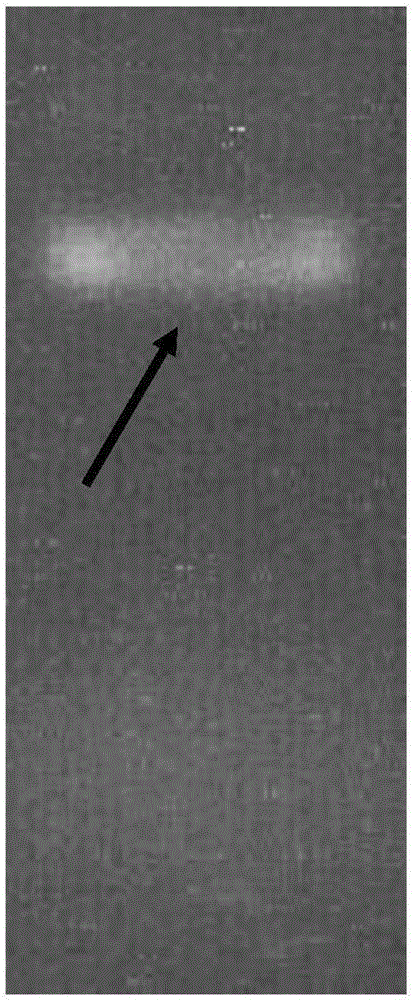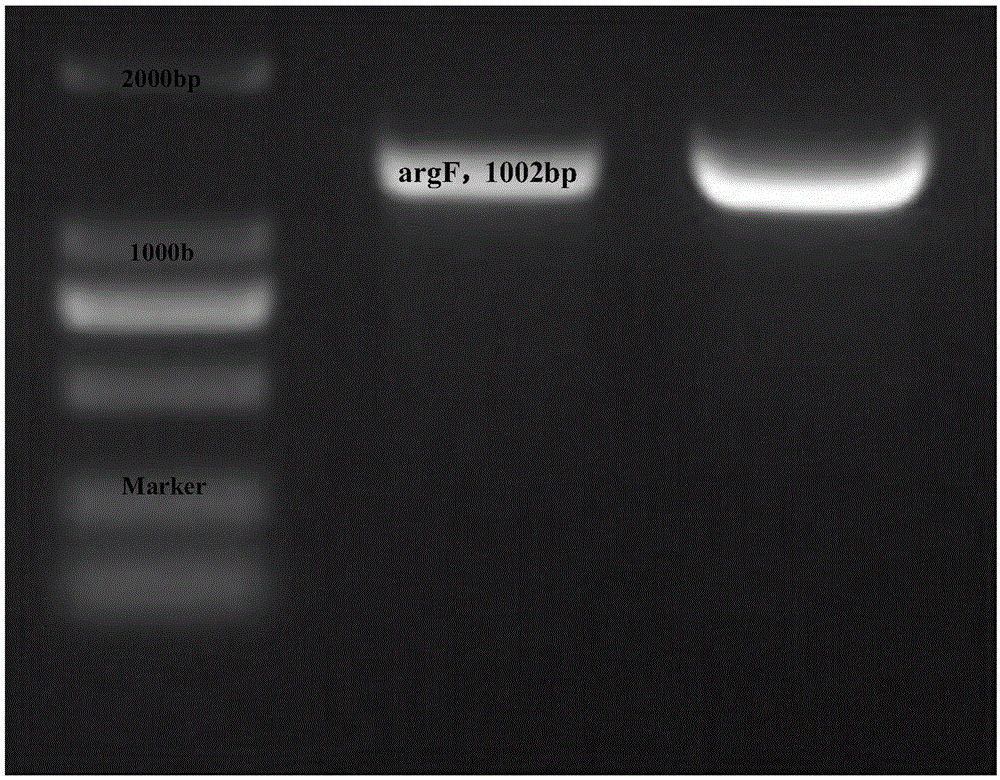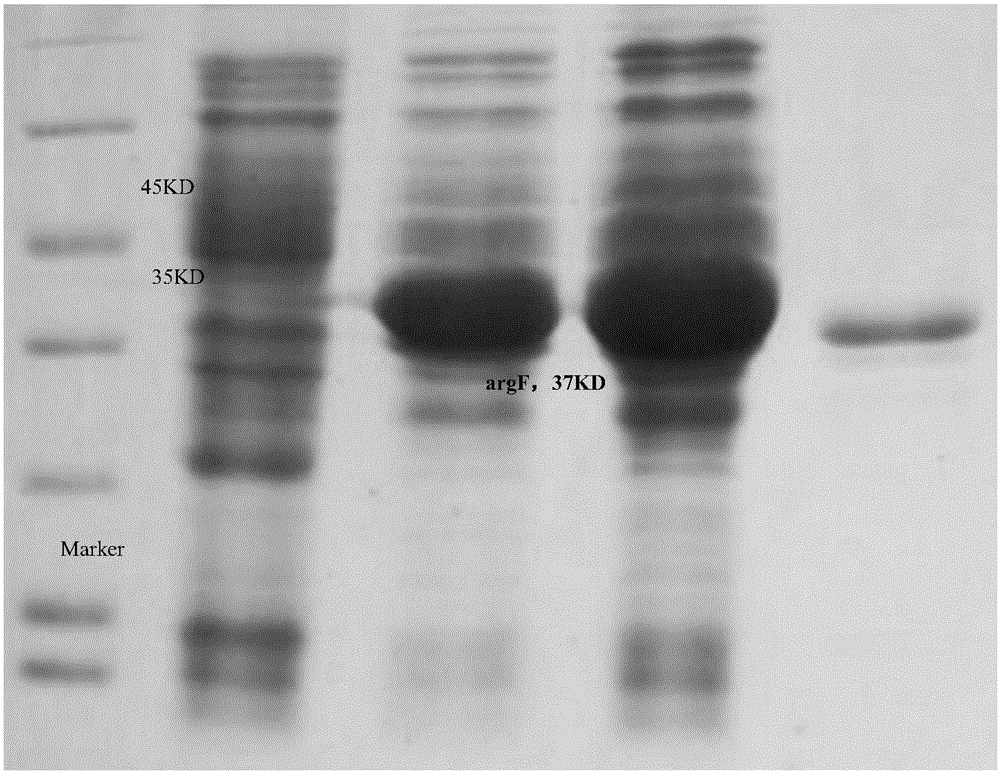Enterobacter glyphosate-tolerant gene argF, and coding protein and application thereof
A glyphosate-resistant and Enterobacteriaceae-resistant technology, applied in the field of genetic engineering, can solve the problems of weak gene resistance and few genes to be excavated
- Summary
- Abstract
- Description
- Claims
- Application Information
AI Technical Summary
Problems solved by technology
Method used
Image
Examples
Embodiment 1
[0039] Example 1: Cloning of Enterobacteriaceae glyphosate-resistant gene argF
[0040] (1) Design primers to extract microbial Enterobacteriaceae DNA:
[0041] The bacterial total DNA extraction kit (purchased from Tiangen Company) was used to extract the DNA of the microorganism Enterobacteriaceae, and the primers were designed according to the existing E. coli argF gene sequence in the NCBI database for homologous cloning. The primer sequences for amplification are:
[0042]SeqID NO.3: Upstream primer 5'-ATTTTCACACACGGACGGG-3';
[0043] Seq ID NO.4: Downstream primer 5'-ATCGGCATAATGCTGGCA-3'.
[0044] (2) PCR amplification, the specific steps are as follows:
[0045] Step 1: Perform PCR amplification using Enterobacteriaceae genomic DNA as a template to obtain specific fragments, and prepare a PCR reaction solution (50uL system, Toyobo, KOD-Plus) according to the following components: 10×PCRBuffer (5uL), 2mMdNTPs ( 5uL), 2mM MgSO 4 (2uL), primers (1.5uL each), DNA (2uL...
Embodiment 2
[0048] Example 2: Expression analysis of gene argF in Escherichia coli BL21
[0049] (1) Design specific primers, add restriction sites NdeI and XbaI and protective bases, use the cloned argF gene as a template to amplify the argF gene, and the specific primers are:
[0050] SeqID NO.5: Upstream primer 5'-CGCGGATCCATGTCTGATCTGTACAAG-3';
[0051] Seq ID NO.6: Downstream primer 5'-CTCCCCAAGCGTCGCCACCTCGAGCGG-3'.
[0052] (2) PCR amplification, product recovery, and TA cloning to PMD19-Tsimplevector, sequencing, the specific operation is the same as in Example 1), select the bacterium liquid that contains the correct amplified sequence, and utilize a plasmid extraction kit (purchased from Axygen Company) Recover the plasmid. The T vector containing the gene and the prokaryotic expression vector pCold were double digested with restriction endonucleases NdeI and XbaI, the recovered fragments were detected on agarose gel, and the cleaved vector and gene were connected with T4DNA l...
Embodiment 3
[0058] Example 3: Expression analysis of gene argF in Arabidopsis
[0059] (1) Select pMDC83 (provided by the National Soybean Improvement Center of Nanjing Agricultural University) as the plant overexpression vector. The resistance of the vector is selected for hygromycin, which is convenient for the screening of transgenic seedlings; the plant expression vector of argF gene is constructed according to the instructions of the Gateway kit operate.
[0060] (2) According to the sequence of the glyphosate-resistant gene argF of Enterobacteriaceae, design primers for amplifying the complete reading frame, and introduce the gateway linker sequence into the upstream and downstream primers:
[0061] SeqIDNO.7: The upstream primer is as follows
[0062] 5'-GGGGACAAGTTTGTACAAAAAAGCAGGCTTCATGTCTGATCTGTACAAG-3';
[0063] SeqIDNO.8: Downstream primers are as follows
[0064] 5'-GGGGACCACTTTGTACAAGAAAGCTGGGTCCTCCCCAAGCGTCGCCAC-3';
[0065] (3) Using the PCR amplification product obtai...
PUM
 Login to View More
Login to View More Abstract
Description
Claims
Application Information
 Login to View More
Login to View More - R&D
- Intellectual Property
- Life Sciences
- Materials
- Tech Scout
- Unparalleled Data Quality
- Higher Quality Content
- 60% Fewer Hallucinations
Browse by: Latest US Patents, China's latest patents, Technical Efficacy Thesaurus, Application Domain, Technology Topic, Popular Technical Reports.
© 2025 PatSnap. All rights reserved.Legal|Privacy policy|Modern Slavery Act Transparency Statement|Sitemap|About US| Contact US: help@patsnap.com



